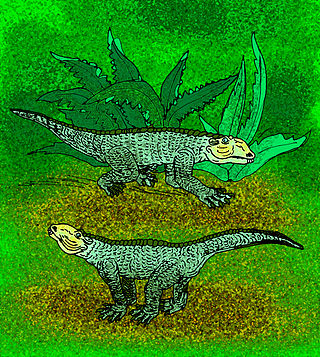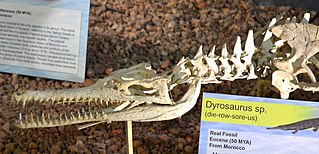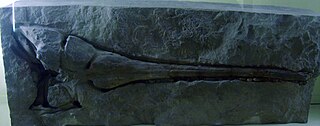
Goniopholis is an extinct genus of goniopholidid crocodyliform that lived in Europe and North America during the Late Jurassic and Early Cretaceous. Like other goniopholidids, it resembled living crocodilians, and probably had a similar ecology as semi-aquatic ambush predators.

Chimaerasuchidae is a family of mesoeucrocodylians. It was erected as a clade in 2004 by Carvalho et al and included Chimaerasuchus from the Early Cretaceous of China and possibly also Simosuchus from the Late Cretaceous of Madagascar. The validity of the clade has been questioned in later studies that found the two genera to be more distantly related.

Anatosuchus is an extinct genus of notosuchian crocodylomorph discovered in Gadoufaoua, Niger, and described by a team of palaeontologists led by the American Paul Sereno in 2003, in the Journal of Vertebrate Paleontology. Its duck-like snout coincidentally makes it resemble a crocoduck, an imagined hybrid animal with the head of a crocodile and the body of a duck.

Comahuesuchus is an extinct genus of notosuchian crocodylomorphs from the late Cretaceous of Argentina. It was described by palaeontologist José Bonaparte in 1991. The type species is C. brachybuccalis from the Santonian Bajo de la Carpa Formation. In 2023 another species, C. bonapartei from the Sierra Barrosa Formation and Portezuelo Formation, was assigned to the genus.

Mariliasuchus is an extinct genus of Late Cretaceous notosuchian mesoeucrocodylian found near Marilia, Brazil. The first bone remains were found and collected in 1995 by Brazilian paleontologist William Nava, in red rocks from the fossiliferous Adamantina Formation. Four years later, it was described as Mariliasuchus amarali, by Brazilian paleontologists Ismar de Souza Carvalho and Reinaldo J. Bertini.

Dyrosaurus is a genus of extinct crocodylomorph that lived during the early Eocene. The name Dyrosaurus comes from sauros (σαῦρος) the Greek for lizard or reptile, and Dyr for Djebel Dyr (mountain) close to where the type species was discovered. It was a large reptile with an estimated body length of 6.5 metres (21 ft).
Malawisuchus is an extinct genus of notosuchian mesoeucrocodylian from the Early Cretaceous Dinosaur Beds of Malawi. It was described in 1997 by Elizabeth Gomani as a member of the family Notosuchidae. The type species is M. mwakasyungutiensis, referring to Mwakasyunguti, the area of northern Malawi where it was found. It was classified as a member of the family Itasuchidae by Carvalho and colleagues in 2004.

Peirosauridae is a Gondwanan family of mesoeucrocodylians that lived during the Cretaceous period. It was a clade of terrestrial crocodyliforms that evolved a rather dog-like skull, and were terrestrial carnivores. It was phylogenetically defined in 2004 as the most recent common ancestor of Peirosaurus and Lomasuchinae and all of its descendants. Lomasuchinae is a subfamily of peirosaurids that includes the genus Lomasuchus.

Baurusuchidae is a Gondwanan family of mesoeucrocodylians that lived during the Late Cretaceous. It is a group of terrestrial hypercarnivorous crocodilians from South America and possibly Pakistan. Baurusuchidae has been, in accordance with the PhyloCode, officially defined as the least inclusive clade containing Cynodontosuchus rothi, Pissarrachampsa sera, and Baurusuchus pachecoi. Baurusuchids have been placed in the suborder Baurusuchia, and two subfamilies have been proposed: Baurusuchinae and Pissarrachampsinae.

Eusuchia is a clade of neosuchian crocodylomorphs that first appeared in the Early Cretaceous, which includes modern crocodilians. Along with Dyrosauridae and Sebecosuchia, they were the only crocodyliformes who survived the K-Pg extinction.
The Adamantina Formation is a geological formation in the Bauru Basin of western São Paulo state, in southeastern Brazil.
Trematochampsidae is an extinct family of mesoeucrocodylian crocodylomorphs. Fossils are present from Madagascar, Morocco, Niger, Argentina, and Brazil. Possible trematochampsids have been found from Spain and France, but classification past the family level is indeterminant. The trematochampsids first appeared during the Barremian stage of the Early Cretaceous and became extinct during the late Maastrichtian stage of the Late Cretaceous.
Eremosuchus is an extinct genus of sebecosuchian mesoeucrocodylian. Fossils have been found from El Kohol, Algeria of Eocene age. It had serrated, ziphodont teeth.
Lomasuchus is an extinct genus of peirosaurid notosuchian known from the Late Cretaceous of Neuquén Province, western central Argentina. It contains a single species, Lomasuchus palpebrosus.

Pholidosaurus is an extinct genus of neosuchian crocodylomorph. It is the type genus of the family Pholidosauridae. Fossils have been found in northwestern Germany. The genus is known to have existed during the Berriasian-Albian stages of the Early Cretaceous. Fossil material found from the Annero and Jydegård Formations in Skåne, Sweden and on the island of Bornholm, Denmark, have been referred to as a mesoeucrocodylian, and possibly represent the genus Pholidosaurus.
Shartegosuchidae is an extinct family of Late Jurassic and Early Cretaceous crocodylomorphs. The family is named after the Late Jurassic Shar Teeg Beds in southwestern Mongolia, from which most shartegosuchid remains have been found. Five genera are currently assigned to Shartegosuchidae: Shartegosuchus, Nominosuchus, Kyasuchus, Adzhosuchus, and Fruitachampsa. Shartegosuchus, Nominosuchus, and Adzhosuchus all come from Shar Teeg, while Kyasuchus is known from the Early Cretaceous of Russia. Fruitachampsa is known from the Late Jurassic Morrison Formation of the western United States.

Morrinhosuchus is an extinct genus of notosuchian crocodyliform from the Late Cretaceous Adamantina Formation of Brazil. It is known from a mandible and a portion of the front of the skull collected from the municipality of Monte Alto in São Paulo state. Morrinhosuchus refers to Morrinho de Santa Luzia, a hill nearby the collection site of the holotype, while luziae refers to the chapel of Santa Luzia, which is located on top of the hill.
Candidodontidae is a family of notosuchian crocodyliforms. It was originally used in 2002 as a name for a clade that includes the genera Araripesuchus, Candidodon, and Malawisuchus. Later in 2004 the family was formally defined as a node-based taxon including Candidodon itapecuruense and Mariliasuchus amarali. A 2009 study redefined Candidodontidae as a stem-based taxon which included Candidodon, Malawisuchus, and possibly Mariliasuchus.
Pepesuchus is an extinct genus of carnivorous metasuchian from the Late Cretaceous period. It is a peirosaurid which lived during the Campanian and Maastrichtian stages of the Late Cretaceous in what is now state of São Paulo, Brazil. It was a semiaquatic crocodylomorph.

Caipirasuchus is an extinct genus of sphagesaurid notosuchians known from the Late Cretaceous of northern São Paulo State, southeastern Brazil. The type species, C. paulistanus, was named in 2011. A second species, C. montealtensis, was referred to Caipirasuchus in 2013 after having been named in 2008 as a species of Sphagesaurus. A third species, C. stenognathus, was described in 2014. A fourth species, C. mineirus, was described in 2018. A fifth species, C. attenboroughi, was named in 2021 in honour of David Attenborough.












